
Review: Comes with Tom Clancy's H.A.W.X. game
AMD recently announced its RV790 based Radeon HD 4890 card, and you should know that the RV790 is an improved version of the RV770 you might know as HD 4870’s ticker. The basic specifications are still the same and the only changes the end users should be aware of were done on the clocks.
The Radeon HD 4890 runs at 850MHz for the core, which was tough to reach with the HD 4870 even with watercooled versions. The new GPU is much more flexible and allows us to overclock the core to 900+MHz. This is the reason why AMD allowed its partners to launch overclocked cards on day one, and XFX isn’t the one to miss out on such opportunities. Today, we’re proud to present the Radeon HD 4890 900M XXX, which as the name suggests runs at 900MHz.
Currently, all the HD 4890 cards come with reference cooling and PCB, and the same goes for XFX’s card. This means that the only difference is the sticker and the clocks. You can see it on the following photo.

One thing that will surely separate the XFX’s card from the rest of the pack sitting on the shelves is the box, which is quite unusually shaped. XFX made X-shaped boxes before, but we don’t recall them being this detailed and well made. Apart from the looks, another thing might catch your eye and it’s Ubisoft’s H-A-W-X gift game.

XFX is probably the partner that changed the box design most frequently, and its latest series on the picture above are the compact boxes we’ve grown to really like.

The basis for the new box is a small box similar to the one on the picture above, but some extra cardboard was added to form the letter X.

An interesting design like this still leaves enough space to write all the important information.
The card comes with 1GB of GDDR5 memory, DirectX 10.1 support, 800 stream processing unites, Unified Video Decoder 2 (second generation), onboard HDMI with 7.1 surround sound, PCI-Express 2.0, Dynamic Power Management, etc. The Tom Clancy’s H-A-W-X gift-game comes with DX10.1 support and it’ll come in handy if you’re gaming on Vista or Win7 you can. Note that only AMD Radeon cards currently offer DX10.1 support, and we couldn’t help but notice a higher frame count when DX 10.1 is used, as opposed to the standard DX 10 settings. Geforce cards can’t do DX 10.1 however, so AMD is one step ahead in this game.

XFX’s packaging reminded us of a puzzle of some kind, as reaching the graphics card was no easy task.

All the basic equipment is in the box. You’ll find the Crossfire bridge connector for multi GPU technologies, meaning if you’d like to add another card or three to your CrossFireX chain, DVI-to-HDMI dongle, DVI-to-VGA dongle, two power cables with dual 4-pin Molex to 6-pin PCI Express adapter, HD Component output dongle, S-Video to Composite adapter, driver CD, user’s manual and the priceless “Do Not Disturb I’m Gaming” sign.

XFX HD 4890 900M XXX comes with reference cooling that’s quiet in idle mode, and although it gets loud in 3D, it’s still far from intrusive.

The fan is kept from the HD 4870’s cooler, and it’s NTK Technologies’ CF1275-B30H-C004 DC12V 1.0A. You can see it on the following picture.

Higher clocks on the HD 4890 made AMD alter the HD 4870’s cooler a bit. They added more copper for better dissipation and the cooler still pushes hot air out of the case.

This time, AMD used three copper heatpipes going from the copper base to the heatsink, whereas the HD 4870’s cooler had two. The new cooler uses one 8mm and two 6mm whereas HD 4870’s uses two thicker, 8mm pipes. Aluminum surface is still the same, meaning the dissipation surface is unchanged. Also, you’ll find an additional short copper pipe above the power regulation area.

The PCB was slightly altered mostly to regulate the additional power requirements, a direct result of higher clocks. The changes are most visible in the back, on the area around the green sticker. Underneath you’ll find a picture of XFX HD 4890 followed by the HD 4870.


The card requires two 6-pin power cables and the power connectors are still where they were on the HD 4870.

The following photos show a part of HD 4890, and then a part of HD 4870 where power management components are located.
AMD used two Voltera VT1165 voltage controllers on the new card. One handles VGPU core voltages and the other is in charge of memory voltage. You can see them on the picture located next to the white pin-head fan power connector. Software voltage changes are possible, and we’re sure some of the partners will use it to their advantage, which would surely make 1GHz core speed within a grasp.
Another detail not featured on the HD 4870’s PCB is a place for the 8-pin power connector, which although unused shows that AMD did some work on it.
HD 4890 will draw 190W at max whereas the HD 4870 consumed 160W. AMD implemented dynamic frequency regulation, but it only applies for the GPU so the memory will keep running at 975MHz in both 3D and 2D. If the memory downclocked when in 2D mode it would’ve surely reflected on the overall consumption.


The memory interface is still 256-bit, but thanks to high GDDR5 clocks it has a bandwidth of 124.8GB/s. Note that GDDR5 memory offers double the bandwidth of identically clocked GDDR3 memory. This means that 512-bit GDDR3 offers the same bandwidth as the 256-bit GDDR5, provided they run at same speeds.
Just like the reference card, XFX’s model comes with 1GB of GDDR5 memory clocked at 975MHz (3900MHz effectively). The card features Qimonda’s IDGV1G-05A1F1C-40X memory. Although this memory is rated at 1000MHz, on the card it runs at 975MHz, which means you could easily squeeze out more.

RV790 offers 7.1 audio as well, courtesy of Realtek HD Audio processor which is integrated directly into the GPU silicone. There’s no need for additional cables, unlike Nvidia’s offerings where you’ll be using a SPDIF cable to bring the audio to the card if you want to send both video and audio to your HDTV device via one cable. This card provides HDMI via the provided DVI-to-HDMI dongle and the I/O panel features two dual-link DVI outs as well as S-Video out. UVD 2 video decoding engine will also provide benefits such as options dual-stream decoding and dynamic contrast enhancement.

Reference HD4890 card on the photo below, looks like the XFX’s card, albeit with a different sticker. Its clocks are 850MHz core and 975MHz for the memory (3900MHz effectively).

Before we move onto our testing, let us remind you of the best AMD’s single GPU card specs. The photo below shows that the card runs much faster than the HD 4870 and that its overall performance is better. Higher clocks provide the HD 4890 with processing power of 1360 GigaFLOPs, whereas the HD 4870 has 1200 GigaFLOPs.
Note that Radeon HD 4850 runs on the same RV770 core like the HD 4870 and the only difference is the clocks. However, the HD 4850 uses GDDR3 memory, unlike the HD 4870 whose GDDR5 memory secures it a much higher bandwidth.
If we compare the transistor count on RV790 and RV770 chips we see little has changed. The RV790 has 3 million transistors more than the RV770, and they’ve been used in strengthening the core and preparing it for higher clocks. The core is isolated with a decap ring, meaning decoupling capacitors used to suppress electromagnetic interference. AMD did some power management changes as well and it led to lower consumption than on the HD 4870.
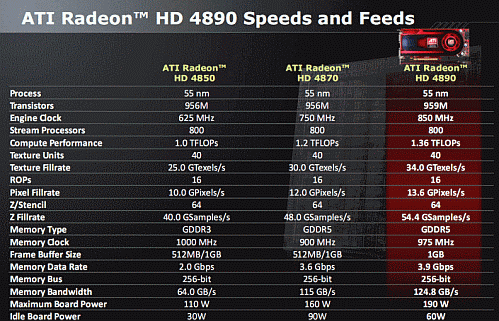
TestBed
Motherboard: MSI P45D3 Platinum ( Provided by: MSI );
Processor: Intel Core 2 QX9770 Extreme edition at 3.6GHz ( Provided by: Intel );
Memory: Corsair Dominator 12800 7-7-7-24 ( Provided by: Corsair);
HDD: WD VelociRaptor 300G 10,000RPM ( Provided by: SmoothCreation );
Driver: ATI_VistaWin7_Radeon_4890_8.592.1RC1_March26.exe
Nvidia_182.06_geforce_winvista_32bit_english_whql.exe
Vista 32 SP1
We’ve tested Sapphire HD 4890 and HIS HD 4890 Turbo cards a few days ago and we know that the Radeon HD 4870 falls behind by about 10%. Today we included the XFX HD 4890 900M XXX card running at 900MHz. So, it’s a factory overclocked card by 50MHz above reference and memory at reference 975MHz.
In the tables we also include one of the fastest GTX 260 cards – Gainward’s GTX 260 GLH card (650MHz GPU / 1,100MHz memory) which beat AMD’s latest card in quite a few tests but at the same time costs some €20 more.
Futuremark Tests
3DMark06 shows that Sapphire’s reference HD 4890 is off to a good start and it beats the HD 4870 1GB and the GTX 260 by 7% and 3% respectively. XFX’s and HIS’s cards run at same clocks so they score almost identically. XFX’s overclocked card beat the HD 4870 by about 8%, but it didn’t manage to outrun Gainward’s 260 GLH card.

3DMark Vatage shows that the HD 4890 runs about 10-13% faster than the HD 4870 1GB. Geforce GTX 260 is faster and it took the Xtreme settings to match its performance to Sapphire’s HD 4890. Gainward’s GLH is still on top and has no trouble beating both XFX HD 4890 XXX and HIS HD 4890 Turbo cards by about 4% at Xtreme settings.



Gaming
Far Cry 2
FarCry 2 is every graphics card’s nightmare, but HD 4890 handled itself like a champ. It outran the GTX 260 Core 216 card in each test, most notably at 1920x1200 where the GTX took the heaviest beating by as much as 20%. On the aforementioned resolution as well as 2560x1600, GTX 260 cards run a bit slower but as soon as we turned the filters on, the HD 4890 found its competition to be tough nuts.








Left 4 Dead
It seems like Left 4 Dead developed a taste for AMD’s cards, as the GTX 260 Core 216 loses at every single resolution. The new AMD’s cards outran Gainward’s GLH card as well, up until the high 2560x1600 resolution.
We’ve again noticed that GTX 260 cards are faster with antialiasing filters, and that there’s usually very little to separate them provided filters are off. The higher the resolution – the lower the difference, but the GTX 260 GLH managed to win at the highest tested resolution.








World in Conflict
With antialiasing in the game, the HD 4890 does much better than its HD 4870 cousin. At 1920x1200 and no filters on, the difference between the cards is mere 4%, whereas the same resolution with antialiasing and aniso filters on sees the difference almost triple – 11%.
While GTX 260 was on HD 4890’s tail in Left 4 Dead, tables have turned in World in Conflict. It took a 1920x1200 resolution for the AMD’s new card to catch up with the GTX 260, and the highest tested resolution, 2560x1600, sees it even win by 2%. At the same resolution, the XFX HD 4890 XXX beats the reference GTX 260 by 7%.








Tom Clancy's H.A.W.X
XFX is bundling Tom Clancy's H.A.W.X game with its HD 4890
cards, and this game is one of the big titles that feature support for
DirectX 10.1.
At 2560x1600, without DirectX 10.1 the card scores 45 FPS. With DirectX 10.1 the same card at the same resolution scores 51FPS.
At 1920x1200 without AA and without DirectX 10.1 it scores 62FPS while
with DirectX 10.1 enabled the same game scores 70 FPS. The same
resolution but with AA and without DirectX 10.1 XFX scores 48 FPS while
with DirectX 10.1 enabled it scores whopping 57 FPS. We are talking
about 10 to 15 percent difference which is a lot.
With Nvidia cards, none of which have support for DirectX 10.1 there is
no option to turn this feature on in the game. It took ATI long enough
but at least with this title they made a huge difference with its
ability to support DirectX 10.1.
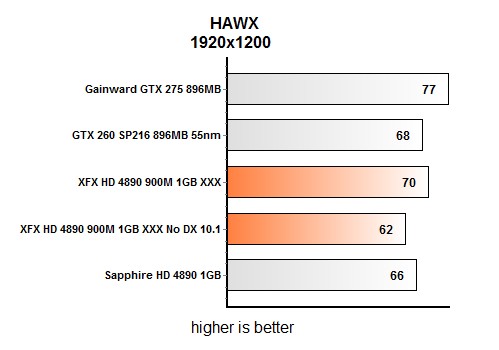
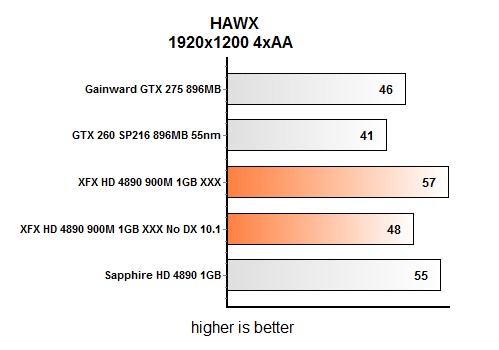
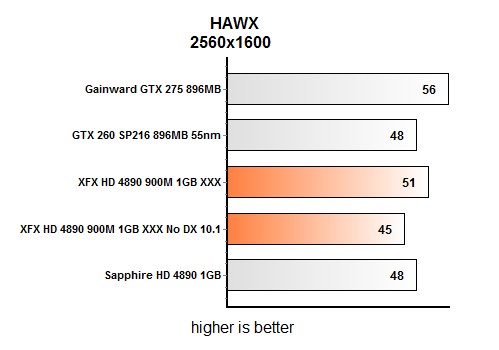
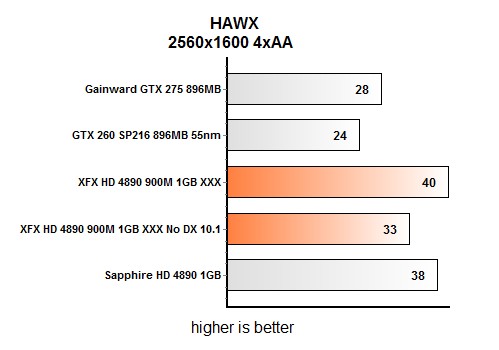
GPU Temperatures

As you can see, HD 4890 thermals are great, and we see XFX’s overclocked card at same temperatures as Sapphire’s reference one. Additional overclocking and auto fan rpm regulation results in temperatures of 90 degrees Celsius. This is still on the safe side, and great considering the card is overclocked to 970MHz. If you choose to increase the fan rpm to max, which has proven to be too loud for our taste, the temperatures duck to 74°C.
The fan is quite loud when the card is in 3D mode, but it’s still not that serious. In idle mode it’s quiet enough, but note that it’s louder than the one on GTX 260 cards.
Overclocking
As we mentioned before, we managed to overlcock XFX HD 4890 900M XXX to 970MHz and the card ran stable while gaming and testing. It took approximately one hour for us to test it with Vantage mark, but FurMark unfortunately revealed some image artifacts.
This little OpenGL tool ran stable at 970MHz core, but due to artifacts, we ended up lowering the GPU clocks until the artifacts were gone. We finally achieved that at 925MHz.
Other HD 4890 cards did similar. Sapphire’s HD 4890 ran at 960MHz core, and HIS’ HD 4890 Turbo ran stable in gaming at 985MHz. We again took a shot at the FurMark test, and it revealed artifacts in both scenarios.
We then downclocked the cards and it also took the 925MHz clock to get rid of the artifacts on Sapphire’s HD 4890, whereas HIS managed to lose the artifacts at 940MHz.
We had no trouble overclocking the memory on all the cards to 1150MHz.
Below you’ll see the results of overclocking the HD 4890 to 960MHz core and the memory to 1100MHz (4400MHz effectively). The results of all three HD 4890 cards were almost identical, give or take 0.5%, so we marked them all as HD 4890 OC 960MHz.
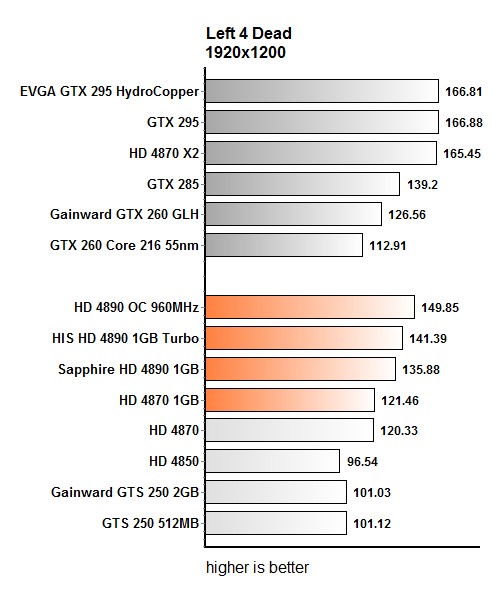
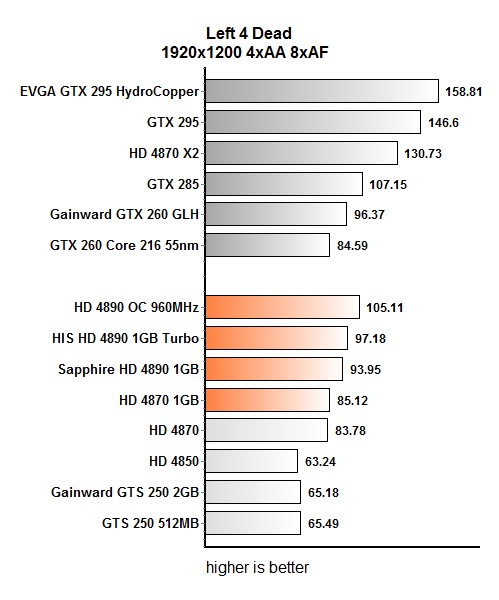
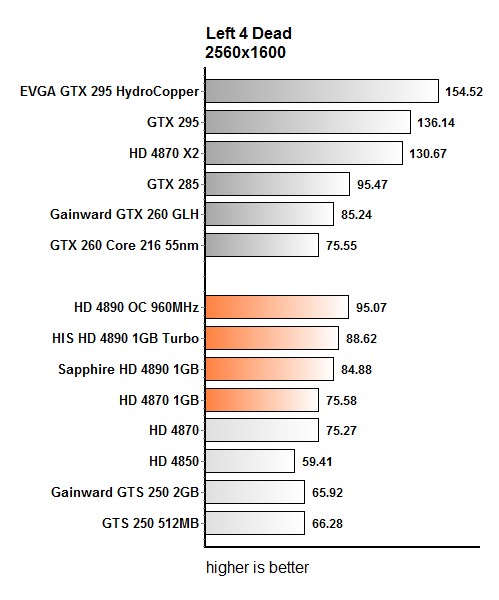
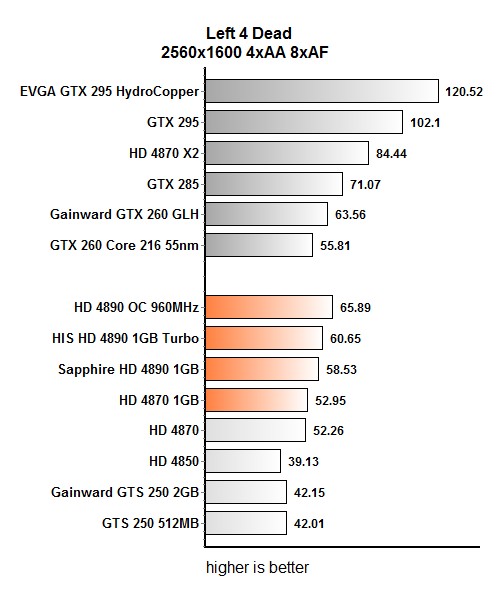
Consumption
Although AMD managed to lower the HD 4890’s consumption compared to HD 4870 in idle mode, the GTX 260 is still better. As we mentioned before, the fact that the HD 4890’s memory runs at 975MHz in both 3D and 2D modes is the culprit. GPU downclocks from 850MHz to 240MHz in idle mode.


Conclusion
AMD Radeon HD 4890 is without a doubt faster than the HD 4870 and GTX 260, but Nvidia has another ace up its sleeve – the Geforce GTX 275. The card was launched on the same day as the HD 4890, probably to spoil AMD’s fun. We still didn’t get a chance to test this card, but the results we’ve seen suggest that it’s slightly faster than the new Radeon. Let’s get real though – HD 4890 is a great graphics card with great performance and priced at only €210, which is the lowest priced reference card. XFX sent us their overclocked XFX HD 4890 900M XXX, which runs at 900MHz and we’d dare to guess it should sell somewhere around €240.
With the graphics card, XFX will give away Tom Clancy’s H.A.W.X game, which features DX 10.1 support. This feature is currently exclusive to AMD’s cards, as Nvidia decided not to implement this but rather to switch directly to DX11 whenever it shows its face. Now however, we’d sincerely recommend turning DX10.1 on in games that support it, as AMD’s cards will use it well and surely run faster than Geforce cards.
XFX HD 4890 900M XXX comes with 1GB of GDDR5 memory, which is HD 4890’s default video buffer size. The memory runs at reference 975MHz or 3900 effectively if you will. If you crave overclocking, this card will offer a lot of flexibility.
XFX HD 4890 900M XXX is currently the best and fastest AMD’s single-GPU card, and if you decide on buying it we promise you won’t regret it.
